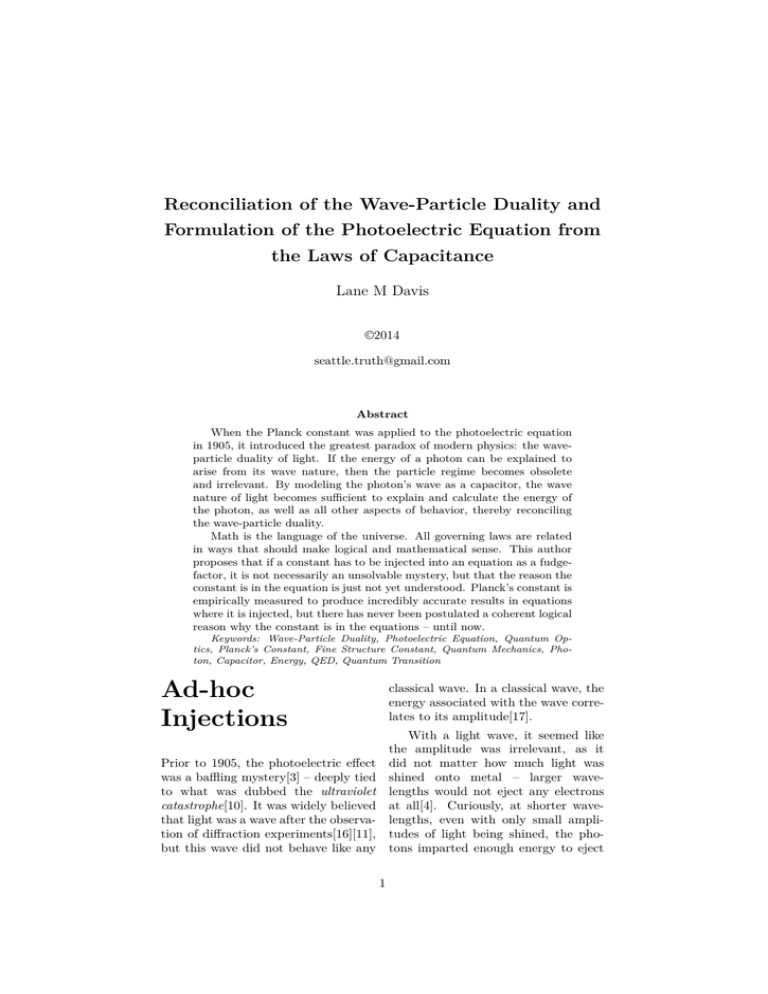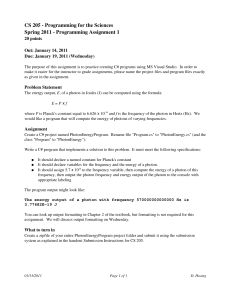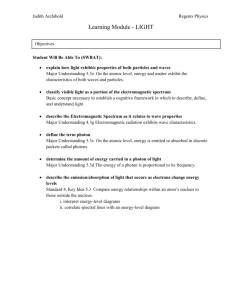
Reconciliation of the Wave-Particle Duality and
Formulation of the Photoelectric Equation from
the Laws of Capacitance
Lane M Davis
©2014
seattle.truth@gmail.com
Abstract
When the Planck constant was applied to the photoelectric equation
in 1905, it introduced the greatest paradox of modern physics: the waveparticle duality of light. If the energy of a photon can be explained to
arise from its wave nature, then the particle regime becomes obsolete
and irrelevant. By modeling the photon’s wave as a capacitor, the wave
nature of light becomes sufficient to explain and calculate the energy of
the photon, as well as all other aspects of behavior, thereby reconciling
the wave-particle duality.
Math is the language of the universe. All governing laws are related
in ways that should make logical and mathematical sense. This author
proposes that if a constant has to be injected into an equation as a fudgefactor, it is not necessarily an unsolvable mystery, but that the reason the
constant is in the equation is just not yet understood. Planck’s constant is
empirically measured to produce incredibly accurate results in equations
where it is injected, but there has never been postulated a coherent logical
reason why the constant is in the equations – until now.
Keywords: Wave-Particle Duality, Photoelectric Equation, Quantum Optics, Planck’s Constant, Fine Structure Constant, Quantum Mechanics, Photon, Capacitor, Energy, QED, Quantum Transition
Ad-hoc
Injections
classical wave. In a classical wave, the
energy associated with the wave correlates to its amplitude[17].
With a light wave, it seemed like
the amplitude was irrelevant, as it
Prior to 1905, the photoelectric effect did not matter how much light was
was a baffling mystery[3] – deeply tied shined onto metal – larger waveto what was dubbed the ultraviolet lengths would not eject any electrons
catastrophe[10]. It was widely believed at all[4]. Curiously, at shorter wavethat light was a wave after the observa- lengths, even with only small amplition of diffraction experiments[16][11], tudes of light being shined, the phobut this wave did not behave like any tons imparted enough energy to eject
1
Lane M Davis ©2014
all rights reserved
electrons[4]. In 1900, by observing
a pattern in blackbody radiation and
making the then-outlandish assumption that energy came in discrete packets, Max Planck was able to give
a formula which described the observed distribution of energy among
the emitted wavelengths[3], which led
him to formulate the Planck Radiation
formula[19], which introduced a new
constant, h. Planck did not realize the
applications for his constant and did
not truly believe in the discrete nature
of energy; he believed it to be an artifact of a flawed mathematical model[3].
Everything changed in 1905. With
his revolutionary idea of a fixed velocity for light, Einstein was able to
give every wavelength a corresponding
frequency[23]. He then took Planck’s
newly discovered constant, and injected it ad-hoc[4] into a very simple
equation: E = hf .
Einstein did not understand how,
or why[1], but when he multiplied
Planck’s constant by the frequency
of light, it produced the experimentally proven energy levels for all known
wavelengths. He could not explain
why Planck’s constant is the conversion factor between the frequency of
light and its energy[1], but it undoubtedly worked. Quantum optics was
born.
The idea that the energy of a
photon came from its frequency introduced the wave-particle duality[25].
The energy in this regime came from
the wave’s frequency, instead of the
wave’s amplitude, which gave the photon a particle nature even though
it behaved like a wave in diffraction
experiments[25]. This ad-hoc solution
was heralded as one of the biggest
breakthroughs of the century, and Einstein eventually won his only Nobel
prize for this simple equation, despite
the fact that it could not be rationalized or explained by anyone why
Planck’s constant was in the equation
in the first place[5]. Planck vehemently
disagreed with Einstein’s conclusion
that energy was inherently quantized
or particle in nature, and saw Einstein’s formulation as “nothing more
than a mathematical trick”[3].
This author contends that Planck
was right all along – that the particle
nature of the wave is just a mathematical artifact that was hitherto misunderstood, and that there is a logical
reason why Planck’s constant is a conversion factor between the frequency
of a photon and its energy, and that
the photoelectric equation can be formulated logically by the application of
commonly known laws.
Capacitance of
the Photon
Fig. (1)
The first step to achieving this is to
model the photon as a parallel plate capacitor. Undoubtedly, the photon has
no net charge, but carries a positive
and negative charge at different times
as it propagates through space[13][28].
The photon also displays another characteristic inherent to capacitors – it is
essentially connected to positive and
negative terminals; the atom emitting
energy (positive lead) and the atom
absorbing energy (negative lead). Despite these two similarities, it may
2
Lane M Davis ©2014
all rights reserved
seem illogical that this fundamental aspect of nature could or should be compared to a capacitor. At face value, a
photon does not seem to exhibit any
of the characteristics of a set of plates.
This misunderstanding is because the
photon is usually visualized from the
frame of reference of an outside observer, where it propagates through
both time and space. It is necessary to
visualize what the photon experiences,
not what the outside observer experiences from the photon.
From the frame of reference of the
photon, many things change, and the
system can then be examined electrostatically. For instance, the photon is
traveling at the speed of light, therefore because of the implications of special relativity and the Lorentz transformation, the photon does not experience time[22]. Time does not exist
for the photon. Because there is no
time, this means the photon occupies
both the positive and negative states
simultaneously. In reality it is alternating between the positive and negative charge sinusoidally through spacetime, as an outside observer would see
(if one could hypothetically observe a
photon without interfering with it in
some way), but from the frame of reference of the photon there is no time,
only space, so it is indeed both positively and negatively charged at the
same time. This fits the first aspect
of a plate capacitor; having a charge
differential.
traveling in a line. Fig. (2) Is a horrible representation of reality, although
it does display some of the physical
attributes and is an easy model for
the Luddite stuck in the Newtonian
regime to digest. The uncertainty principle tells us this model is not accurate; that a particle has neither a perfectly defined history nor a perfectly
defined location[24]. Single slit Fraunhofer diffraction shows that a photon
does indeed have a width, as when the
slit is closed tighter than one wavelength, the wave interferes with itself,
and produces strange but mathematically logical results[16]. Therefore, the
photon not only has a wavelength, but
it also has a width. It also has a distance between the positive and negative components (Fig. 2). The distance between the positive and negative charge peaks of the sine wave is
half a wavelength.
When the photon is viewed as
frozen in time, it does display the characteristics of a plate capacitor; two
oppositely charged surfaces both with
a length, a width, and separated by
a distance. It must be noted that
the photon is positive for half of its
length, and negative for half of its
length (Fig. 2); so the length of each
plate is half a wavelength. It must
also be noted that the photon does
not become even semi-localized until
it interacts with a particle[26]. From
emission, it travels through spacetime
as nothing more than a superposition
of possibilities, propagating according
Fig. (2) to Schrödinger’s wave equation[21] until the wavefunction collapses upon
absorption, where these three dimensional properties take shape. Knowing the three properties of length,
width, separating distance, and that
the dielectric in this case is spacetime itself[29], with a vacuum permittivity of ε0 , we can calculate for the
Another misconception is that a capacitance of the photon using the
photon is a one dimensional particle standard equation for an ideal paral3
Lane M Davis ©2014
all rights reserved
tion, and plugging in e for the charge
Q, produces:
lel plate capacitor with the vacuum as
the dielectric[18].
e2
(4)
2ε0 λ
It would suffice to just solve for
Plugging in 21 λ for length, λ for
E
to
calculate the correct energy lev1
width, and 2 λ for distance, and then
els
for
the entire electromagnetic speccanceling, we produce:
trum, but something very interesting
happens when we put this equation in
C = ε0 λ
(2)
terms of frequency, which is possible
because f = λc [23].
Solving for E, and converting wavelength to frequency by substituting
λ = fc , it produces:
2 e
f
(5)
E=
2ε0 cα
The standard equation for calculating
The terms in the brackets equals
the potential energy stored in an ideal
Planck’s
constant, h. The equation is
capacitor in terms of capacitance is
equivalent
to the photoelectric equa[15]:
tion; E = hf .
Q2
E=
(3)
2C
C=
ε0 A
D
Eα =
(1)
Energy of the
Photon
Conclusion
In this case, the charge (Q) is the
elementary charge (e), which is the
maximum charge of the photon during its sinusoidal peaks. It must be
emphasized that the photon has no
physical properties until it interacts
with another particle[26]. We are not
trying to solve for the energy of a
photon in free space. Such a photon cannot be measured, therefor according to the Copenhagen Interpretation, it does not truly exist[6]. We
are solving for the energy of a photon
that is interacting with an electron (or
more accurately, the electron’s virtual
photon[20]) through the action of electromagnetic coupling[12]. Therefore
we must take into account the strength
of the coupling, which is the fine structure constant, α[12]. We are solving
for the energy of the coupled photon,
so we must place α into the equation
to solve for the coupled energy.
Inserting Eq. (2) into Eq. (3), placing α on the energy side of the equa-
Nature is written with mathematics.
Math is all nature knows[8]. When
equations work out to produce accurate predictions, they describe something about nature. It is up to us to
sit down, listen, and try to figure out
what the math is saying; to decipher
what we learn and put it into the syntax of human language. These equations are telling us that the photon is
an ideal capacitor.
When physics equations work, it is
never purely coincidence. This is the
reason why string theory took off in
1970[9], when the equations produced
accurate results by modeling particles
as reverberations on a string. In the
case of a photon modeled as a plate capacitor, not only does the math work
to produce accurate results for every
known wavelength, but deep down at a
fundamental level a photon makes logical sense as a capacitor. A capacitor
4
Lane M Davis ©2014
all rights reserved
stores energy through a charge differential, and that’s exactly what a photon does, with spacetime as the dielectric, and connected to two atoms which
act as the positive and negative lead.
In this regime it becomes clear
what gives rise to Planck’s constant
in the famous photoelectric equation.
It is not a fundamental property of
nature, as Planck ardently argued[3]
– it is an aggregate constant, birthed
by the relationship of capacitance and
energy and the uncertain location of
the photon, in conjunction with relativity, the permittivity of free space,
and the strength of electromagnetic
coupling. This reconciles the waveparticle duality[25], as now we can see
that the energy of the photon is not
caused by its frequency, or its particle
nature, it is simply caused by its capacitance, and its corresponding voltage (V = Q
C [14], where Q is the elementary charge) which is determined
by its wavelength. The smaller the
wavelength, the smaller the capacitance, which means a larger voltage,
and therefore more energy in the system. The voltage of the photon is the
amplitude in this wave, because it is
an electrical system. The energy of a
photon does relate to the wave’s amplitude, just in an unsuspected way, because it is an electrical wave, and must
be thought of as such.
The energy of the photon is caused
by its wave nature after all, just as
the probability of its location is caused
by its wave nature. This is the explanation that Planck knew in his heart
must exist, although he was unable
to find it. This author concludes
that what is considered a particle after
the wavefunction collapses is nothing
more than a semi-localized smearedout wavepacket that imparts its energy
through the voltage of the three dimensional nature of the wave, as it cannot
be totally localized but has a constant
charge differential due to the elemen-
tary charge. Bohr’s rule of complementarity therefore does not apply to
the Copenhagen interpretation regarding the wave-particle duality[2].
Furthermore, the quantized values
of energy that we observe for the entire
spectrum of light is not due to some
intrinsic particle-side-of-the-duality of
the photon, it is simply due to the conservation of energy and the fact that
each energy level of the atom must
be occupied by what can be modeled
as a standing wave[27]. During quantum transition, the electron must jump
up or down to another standing wave.
The photon itself can occupy any energy imparted to it, and therefore any
wavelength, but because the energy
levels themselves are determined by energy levels where standing waves of the
electron can occur, only certain energy
levels of light can be admitted. Because energy is conserved, these photons contain the exact energy of the
atom that emitted them, and are only
able to be absorbed by atoms which require the exact amount of energy contained in them, giving rise to a totally quantized world. Again, Planck
was right[3], and there is nothing inherently choppy or discrete about the
energy levels of the photon. It is because they can only take the energy
given to them by the captured electron,
which must occupy a standing wave,
which only happens at discrete levels.
Energy is quantized by proxy.
However, there are many questions
left to be answered. This author does
not understand why the fine structure
constant is the value it is for coupling.
According to QED, photons do not interact directly with electrons, they interact with virtual photons given off
by electrons[20]. Therefore, because
photons are shown to be three dimensional capacitors when frozen in
time, and photons interact with electrons through virtual photons, the virtual photons probably also exhibit this
5
Lane M Davis ©2014
all rights reserved
kind of capacitorial behavior – this author suspects that the value might have
something to do with capacitors being wired in series, which lowers the
capacitance of the system. This may
or may not be the case. This author
also suspects that this wave-capacitor
regime can explain why Planck’s constant arises in all of the equations regarding electromagnetic and quantum
interactions.
Although reconciling the wave-
particle duality has its merits, determining why the fine structure constant
has the value it does through logical
analysis is thought to be the equivalent
of the Holy Grail of modern physics[7].
Possibly these new insights on the nature of light can help illuminate that
path. This author feels that all the
fundamental constants are related in
ways which we are only just beginning
to understand.
References
[1] Salama Abdelhady.
Applied Physics Research, 3(2):230, 11 2011.
http://dx.doi.org/10.5539/apr.v3n2p230.
[2] Encyclopaedia
Britannica.
complementarity
principle,
http://www.britannica.com/ebchecked/topic/129874/complementarityprinciple.
[3] David
Cassidy.
Einstein
on
the
photoelectric
http://www.aip.org/history/einstein/essay-photoelectric.htm.
effect,
[4] A. Einstein. Concerning an heuristic point of view toward the emission and
transformation of light. Annalen der Physik, 17:132–148, 1905.
[5] Nobelprize.org.
The
nobel
prize
in
physics
http://www.nobelprize.org/nobel_prizes/physics/laureates/1921/.
1921,
[6] Univ.
of
Oregon.
Copenhagen
interpretation,
http://abyss.uoregon.edu/j̃s/21st_century_science/lectures/lec15.html.
Lecture 15.
[7] Feynman
Online.
The
mysterious
http://www.fotuva.org/online/frameload.htm?/online/137.htm.
137,
[8] F. David Peat. Mathematics and the language of nature. World Scientific,
1990. http://www.fdavidpeat.com/bibliography/essays/maths.htm.
[9] The Official String Theory Web Site. A brief history of string theory,
http://superstringtheory.com/history/history4.html.
[10] Georgia State University. Blackbody radiation.
[11] Georgia State University. Double slit diffraction, http://hyperphysics.phyastr.gsu.edu/hbase/phyopt/dslit.html#c1.
[12] Georgia State University.
Electromagnetic force coupling constant,
http://hyperphysics.phy-astr.gsu.edu/hbase/forces/couple.html.
[13] Georgia State University. Electromagnetic waves, http://hyperphysics.phyastr.gsu.edu/hbase/waves/emwavecon.html.
6
Lane M Davis ©2014
all rights reserved
[14] Georgia State University.
Energy stored in a capacitor,
http://hyperphysics.phy-astr.gsu.edu/hbase/electric/capeng2.html.
[15] Georgia State University.
Energy stored on a capacitor,
http://hyperphysics.phy-astr.gsu.edu/hbase/electric/capeng.html.
[16] Georgia State University. Fraunhofer single slit, http://hyperphysics.phyastr.gsu.edu/hbase/phyopt/sinslit.html.
[17] Georgia State University. How much power is transported by a string wave?,
http://hyperphysics.phy-astr.gsu.edu/hbase/waves/powstr.html.
[18] Georgia
State
University.
Parallel
plate
capacitor,
http://hyperphysics.phy-astr.gsu.edu/hbase/electric/pplate.html.
[19] Georgia State University. Planck radiation law, http://hyperphysics.phyastr.gsu.edu/hbase/mod6radiation.
[20] Georgia State University.
Quantum electrodynamics
http://hyperphysics.phy-astr.gsu.edu/hbase/forces/qed.html.
(qed),
[21] Georgia State University. Shrodinger equation, http://hyperphysics.phyastr.gsu.edu/hbase/quantum/schr.html.
[22] Georgia State University.
Time dilation, http://hyperphysics.phyastr.gsu.edu/hbase/relativ/tdil.html#c2.
[23] Georgia
State
University.
Traveling
wave
http://hyperphysics.phy-astr.gsu.edu/hbase/wavrel.html.
relationship,
[24] Georgia State University. Uncertainty principle, http://hyperphysics.phyastr.gsu.edu/hbase/uncer.html.
[25] Georgia State University. Wave-particle duality, http://hyperphysics.phyastr.gsu.edu/hbase/mod1.html.
[26] Princeton
University.
Wave
function
collapse,
https://www.princeton.edu/ãchaney/tmve/wiki100k/docs/wave_function_collapse.html.
[27] St.
Mary’s
University.
Electron
standing
wave,
http://ap.smu.ca/demos/index.php?option=com_content&view=article&id=116&itemid=85.
[28] Wikipedia.
Photon
physical
http://en.wikipedia.org/wiki/photon#physical_properties.
properties,
[29] Matt Williams. Dielectric constant, http://www.universetoday.com/83378/dielectricconstant/, Jan 2011.
Acknowledgments
Frank Znidarsic - Discovery of the fundamental relationship between the photon
and the capacitor.
7






